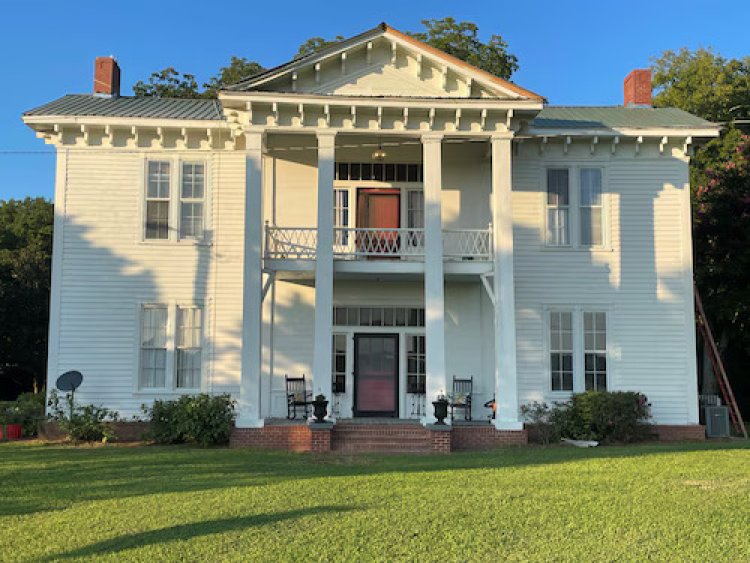Descendants of Alabama Slaves Reunite at Historic Plantation House: ‘Words Can’t Express the Feeling’
Descendants of Alabama slaves reunite at the historic Coats plantation house, reflecting on their ancestors' sacrifices and discovering new family connections.

Antonious Colts embarked on his first journey to a historic house he discovered online, driven by a deep search for his roots. Meanwhile, Ernest Crowder, despite weeks of bedrest due to back pain, traveled from St. Louis to finally see the place where his ancestors were buried, reflecting on their untold stories. Robert Lindsey, who grew up near the plantation, felt a mix of attraction and sorrow as he frequently drove past it.
This weekend, the Coats and Thornton families gathered for their biennial reunion in Etowah County, a small community of around 1,500 residents by the Coosa River. This year’s reunion was special. These families are descendants of the enslaved people who built the plantation house that still stands tall beside the Appalachian Highway, amidst rows of cotton fields.
On Sunday, they were invited into the mansion with its white columns, experiencing its grand interior for the first time. Under the sweltering 95-degree sun, visitors wiped away sweat as they wandered through the rooms and grounds of the house their ancestors built and maintained as property.
For many, this was their first opportunity to enter the halls and relax on the porches of the house. The current owner, a white woman whose family has owned the house for over 150 years, extended the invitation. More than 70 people explored the mansion, reflecting on the lives and sacrifices of their forebears.
“I can’t help but think about what it was like back then,” said Jalyn Marbury, 19, from Gadsden, standing in a receiving room filled with antique furniture and family photos. “What they had to go through. It makes me want to know more about where I came from. It makes me feel closer to my family.”
A History of Hardship and Survival
Situated half a mile from the Coosa River, north of Gadsden, the house was built by Gideon Edward Coats, who bought several hundred acres from the U.S. government. Coats, originally from South Carolina, was drawn by the allure of cheap land taken from the Cherokee Indians. He married a Cherokee woman, although the marriage didn’t last long. A year after buying the property, the Cherokee were forcibly relocated during the Trail of Tears.
Historical records indicate Gideon owned fewer than 25 enslaved people, despite local histories claiming he owned up to 150. These enslaved individuals—George, Sharlett, Dock, Mack, Sarah, and Amanda—are remembered in census records. Their descendants took on the names of Confederate generals post-Civil War.
The land, abundant with wildlife and fertile for crops, especially cotton, provided a comfortable life for its owner but a harsh existence for those enslaved there. Coats and the slaves, along with some Cherokees, built the mansion without nails, using wooden pegs to connect the boards. The 14-room, two-story house with high ceilings and numerous fireplaces still stands amidst cotton fields that bloom each fall.
Bishop Roy Coats, now 82, recalled picking cotton as a child. “There’s an art to picking cotton so you don’t tear up your hands,” he said. “A rhythm to it.” He remembered relatives who could pick hundreds of pounds a day. Over the years, mechanical pickers replaced the need for manual labor.
A Journey of Discovery and Healing
Antonious “Tony” Colts, a 48-year-old Christian rapper from Atlanta, embarked on a quest to learn more about his family after taking a DNA ancestry test. Discovering he was a descendant of Dock Coats, born in 1865, he connected with relatives and learned about their reunion. Despite initial hesitation, he reached out to Lee Posey, the current owner, who welcomed him and shared the house’s history.
Crowder, another Coats descendant, learned about a family murder case from 1910. This shared history resonated with Tony, who reflected on his own life’s path. “Understanding where I come from gives me a better chance of dealing with my challenges,” he said.
Robert Lindsey, who grew up in Coats Bend and later moved to Ohio, returned to the area after retiring. The sight of the plantation house reminded him of his roots and the painful history of slavery. “It’s sweet and sour. It’s history. Some of my ancestors are buried out there,” he said.
Floyd Larry Coats, who was among the first Black students to desegregate schools in Gadsden, visited the house for the first time. Though few stories of their enslaved ancestors have survived, the reunion allowed family members to imagine the physical and mental toll their ancestors endured.
A Home with a History
Twenty years after the Civil War, the house was sold to J.D. Thornton, a Confederate veteran’s son, and remained in the family for many decades. Lee Posey, who has owned the house for 27 years, prepared it for the reunion, decorating each room and sharing stories with visitors.
Posey, who calls the house “a great lady,” decided to open it for the reunion after Tony contacted her. “They should be able to come and see it. Their ancestors built it,” she said. “It means the world to me that they can.”
As the descendants of enslaved people walked through the halls and shared stories, the house stood as a testament to resilience and the enduring human spirit. “Words can’t express the feeling,” said Crowder, as he reflected on the history and the connections rediscovered that day.







